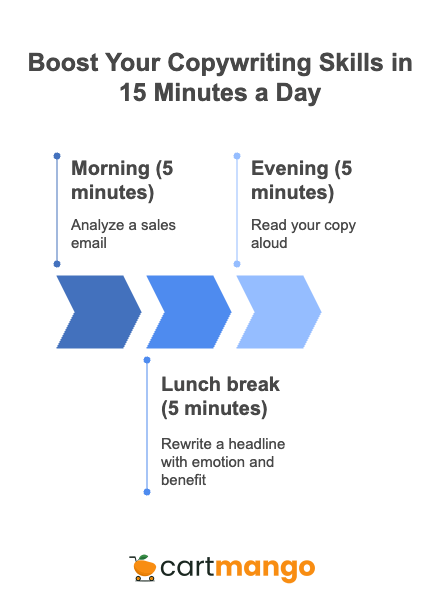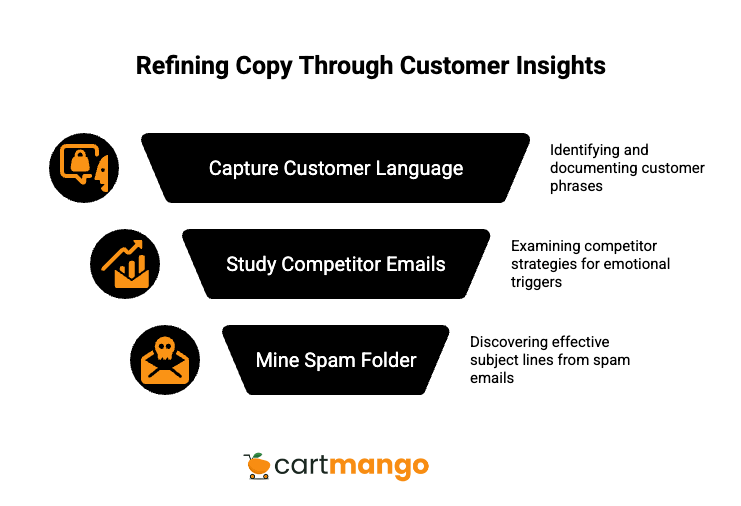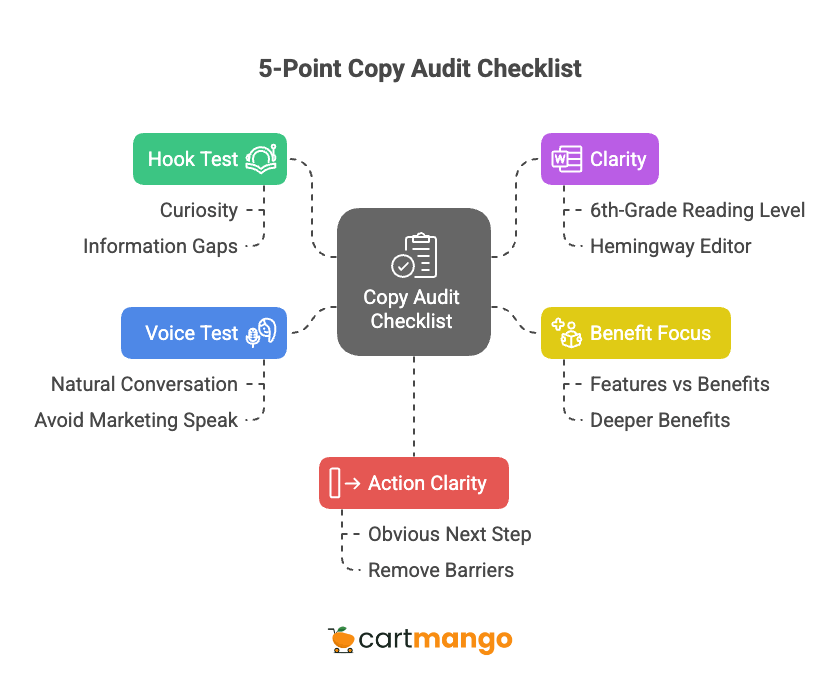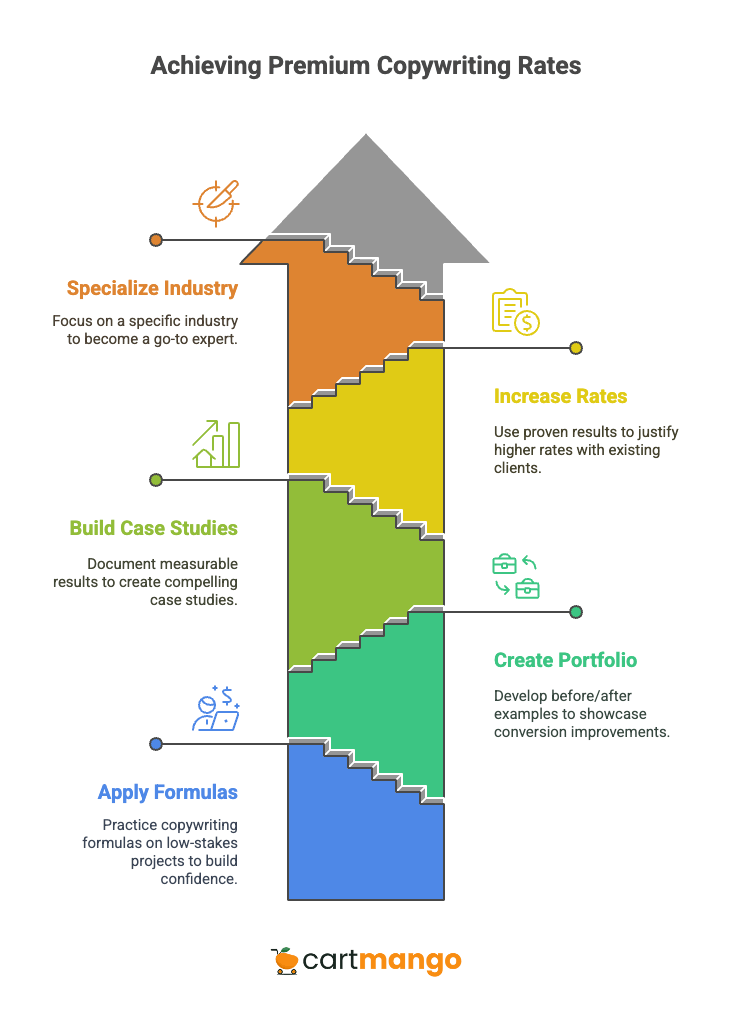For the 15-minute daily system, jump to this section.
For the 5-point copy audit checklist, jump to this section.
–
Why Every Other Copywriting Guide Fails You
Many copywriting articles give you scattered tips without a system to measure if you’re actually improving your copywriting skills.
They assume you’ll magically develop copywriting instincts through osmosis. They tell you to “write compelling copy” without showing you what compelling actually looks like. You’re left guessing whether your improvements are real or imaginary.
My promise is different. This post is a structured 30-day system with measurable results that focuses on immediate income impact. No fluff, no theory you can’t use today.

30-Minute Quick Start
Unlike other guides that require weeks to start, you’ll improve your first piece of copy today.
I’m not asking you to read 47 books or take a $2,000 course. You want improvements now right?
Your immediate action: Open your email inbox right now. Find 3 subject lines that made you click. Write them down. Notice the patterns – do they create curiosity? Promise a benefit? Tell a story?
Here’s what you’re looking for: “The mistake that’s costing you $3,847 every month” uses curiosity plus specific numbers. “Why I stopped using Google Ads (and what I do instead)” creates an open loop that demands closure.
5-minute rewrite exercise: Take your worst-performing email subject line. Apply the curiosity pattern you just found. Instead of “Newsletter Update #47,” try “The mistake 73% of our customers made last month.”
This quick start approach sets the foundation for everything that follows. The patterns you identify now will become the building blocks for more advanced techniques. You’re training your brain to recognize what works before you learn why it works.
Your 15-Minute Daily Copy System
While other guides give vague “practice regularly” advice, this provides specific time blocks. The ones who follow these timeframes will improve faster than those who practice “whenever they feel like it.”

Morning (5 minutes)
Analyze one sales email that landed in your inbox. Highlight the hook that grabbed you. Was it a question? A bold statement? A story opening?
Look for opening lines like “I’m about to share something that will make you uncomfortable” or “This email will either excite you or terrify you.” Notice how these create immediate engagement without revealing the payoff.
Lunch break (5 minutes)
Find one headline online that makes you want to read more. Rewrite it using emotion plus benefit. “How to Save Money” becomes “How I Cut My Grocery Bill in Half Without Eating Ramen Every Night.”
The key is specificity. “Save money” is generic. “Cut grocery bill in half” gives exact results. “Without eating ramen every night” addresses the obvious objection about quality of life.
Evening (5 minutes)
Read your copy aloud.
Your mouth will catch awkward phrasing your eyes miss. If you stumble reading it, your audience will stumble understanding it.
- Pay attention to rhythm and flow.
- Good copy has a conversational cadence.
- If you run out of breath reading a sentence, it’s too long. If words feel clunky in your mouth, they’ll feel clunky in your reader’s mind.
After 30 days, you’ll have analyzed 90 examples and developed a natural conversational writing voice. This isn’t hope – it’s math. 90 examples will rewire how you think about persuasive writing.
These daily habits create the mental framework you’ll need for the proven formulas coming next. Pattern recognition is the foundation of all copywriting skill.
Master 3 Proven Formulas (Not 47 Confusing Frameworks)
This beats generic AIDA by using psychological curiosity gaps instead of boring benefit statements. I’ve watched too many copywriters try to memorize dozens of formulas and end up paralyzed by choice.
Formula | Hook/Attention | Interest Builder | Desire Creator | Action Step |
|---|---|---|---|---|
AIDA Email | Curiosity gap or immediate benefit | “Here’s what happened when I tried this…” | “Imagine if you could [specific outcome]…” | “Get instant access to [exclusive resource]” |
Problem-Solution Post | “Struggling with [ultra-specific problem]?” | “Here’s why [common solution] actually makes it worse…” | “Try this instead: [your counterintuitive solution]” | “Download the free 5-minute fix” |
Social Proof Page | “[Specific Number] [Customer Type] Got [Measurable Result] in [Timeframe]” | Customer success story details | “Join [competitor] customers who switched to us for [specific reason]” | “Join 2,847 others who’ve succeeded – start risk-free” |
Social proof increases conversions by 34% (source). Notice how each action step creates desire instead of just asking for a click. “Learn more” is what weak copywriters write when they can’t think of a real benefit.
Let me show you these formulas in action.
For a productivity app, weak AIDA might say:
- “Attention: Are you disorganized?
- Interest: Our app helps.
- Desire: You could be more productive.
- Action: Download now.”
Strong AIDA says:
- “Attention: The hidden reason you work 12-hour days but accomplish nothing.
- Interest: I discovered this when I tracked every minute for 30 days.
- Desire: Imagine leaving the office at 5 PM with everything important finished.
- Action: Get the free 15-minute daily planning template.”
Pick one formula this week. Use it for every piece of copy you write. Master one before moving to the next. Depth beats breadth when building copywriting skills.
Now that you have proven frameworks, you need to understand who you’re writing for. This brings us to customer research methods that many copywriters overlook.
3 Customer Research Methods
Most copywriters get this backwards – they use industry jargon instead of customer language.
The fundamental mistake is assuming you know how customers think about their problems.
You know the technical solution, but they know the emotional experience. Your job is bridging that gap.

Method #1: The Customer Voice Capture
Read Amazon product reviews in your industry. Focus on 1-star and 5-star reviews. The angry customers tell you exactly what problems you need to solve. The happy customers give you the exact words to describe your benefits.
Write down EXACT phrases for pain points and desired outcomes. Don’t translate them into “professional” language. If customers say “this thing saved my sanity,” don’t change it to “this product improved my mental well-being.”
Here’s an example from a project management software review:
“Before this, I was drowning in sticky notes and felt like my brain was melting from trying to remember everything.”
That’s gold. Use those exact words: “drowning in sticky notes” and “brain was melting.”
Use their language, not your industry jargon. Your copy should sound like your customer talking to their best friend, not like a corporate memo.
Create a customer language document with three columns: problem phrases, benefit phrases, and objection phrases.
Method #2: The Competitor Intelligence
Sign up for 5 competitor email lists today.
Don’t just collect them – study them. Create a Google Doc with their welcome sequences. Notice which emails make you want to buy and which make you want to unsubscribe.
Swipe files should be organized by emotional trigger, not just industry.
Sort your examples by:
- fear
- desire
- urgency
- curiosity
This way you can find the right emotional approach for any project.
When you need to write urgency copy, don’t guess. You reference what’s already working. Here’s what your folder structure could look like: Fear-based opens, Curiosity hooks, Social proof stories, Urgency closes, Objection handling, and CTA variations.
Study the timing of competitor sequences. Do they sell immediately or nurture first? How many emails before the first pitch? What’s the ratio of value to sales content? Map out their entire funnel strategy.
Method #3: The Spam Folder Gold Mine
This might sound crazy, but check your spam folder for subject lines that broke through filters. If it got past spam filters, it’s psychologically compelling enough to grab attention in a crowded inbox.
Screenshot compelling headlines from “junk” sales emails. The spammers are often the most creative copywriters because they have to be. They’re fighting algorithms and human psychology simultaneously.
I found some of my best subject line patterns in spam. Obviously don’t copy their tactics, but study their psychology. “Your account expires in 2 hours” creates urgency. “The weird trick billionaires use” combines curiosity with authority.
Look for patterns in what makes it through filters: personalization, local references, news-style headlines, question formats. These psychological triggers work regardless of the sender’s reputation.
With solid research methods in place, you need a quality control system to ensure your copy actually works. That’s where this next checklist becomes your safety net.
The 5-Point Copy Audit Checklist

1/ Hook Test
Does line 1 create curiosity for line 2? If someone could stop reading after your first sentence and feel satisfied, your hook failed.
Test this by showing only your first line to someone. If they don’t ask “and then what happened?” you need a stronger hook. Good hooks create information gaps that demand closure.
2/ Clarity
Write at 6th-grade reading level for maximum comprehension. Smart people appreciate clear writing. Confused people don’t buy anything.
Use the Hemingway Editor to check reading level. Complex sentences don’t make you sound smarter – they make your message harder to understand. Simple beats clever every time.
3/ Benefit Focus
Every sentence must answer “what’s in it for me?” Features tell, benefits sell. “Our software has advanced analytics” vs “See exactly which marketing campaigns make you money.”
The feature is analytics. The benefit is knowing which campaigns are profitable. The deeper benefit is making more money with less guesswork. Always dig deeper than the surface benefit.
4/ Voice Test
Read aloud – does it sound like natural conversation? If you wouldn’t say it to a friend over coffee, don’t write it in your copy.
Record yourself reading your copy. Listen for robotic phrasing, awkward transitions, and sentences that sound like marketing speak. Real people don’t talk like press releases.
5/ Action Clarity
Is the next step obvious and friction-free? Confused prospects don’t become customers. Make it stupidly simple to take action.
Test this by asking: “What exactly should I do next?” If the answer isn’t immediately obvious, simplify your call-to-action. Remove barriers, not just perceived ones but actual ones.
This checklist has saved me from sending terrible copy more times than I can count. It’s my safety net when I’m too close to the project to see clearly.
Just as important as knowing what to do is knowing what NOT to do. The mistakes below kill more campaigns than bad strategy ever could.
Avoid These 3 Copy-Killing Mistakes
Most guides tell you what TO do, not what NOT to do. Here’s prevention focus that could save your next campaign from bombing completely.
Mistake #1: Leading with “We are…” instead of “You get…”
Your prospects don’t care about your company history. They care about their problems. “We are the leading provider of…” instantly triggers the mental spam filter.
Instant fix: Rewrite your bio’s first sentence to focus on customer outcome. “We help businesses grow” becomes “You’ll get 23% more qualified leads without spending more on ads.”
I see this mistake all the time. It’s killing conversions before prospects even understand what you do. The about page should be about them, not about you.
Here’s the psychology:
Folks are naturally self-interested. They’re scanning for personal relevance. When you lead with company achievements, you’re talking to yourself, not to them.
Mistake #2: Weak CTAs like “Learn More” or “Click Here”
These phrases create zero desire. They’re copy cop-outs that lazy writers use when they can’t think of a real benefit.
Power alternative: “Get [specific result]” or “Solve [specific problem] now.” “Learn more about our services” becomes “Get your first client in 30 days.”
The difference in click-through rates is staggering. Specific CTAs outperform generic ones in my experience. People don’t want to “learn more” – they want to achieve specific outcomes.
Test different CTA phrases: “Start your free trial” vs “Get instant access” vs “Claim your spot.” The winning phrase often surprises you.
What sounds good to you might not motivate your audience.
Mistake #3: Industry jargon instead of customer language
You might know what “programmatic attribution modeling” means, but your customer just wants to know which ads work. Stop trying to sound smart and start trying to be understood.
Research fix: Replace 5 technical terms with phrases from customer reviews today. Use the words your customers actually use when they describe their problems and dreams.
- Create a jargon translation sheet.
- Every industry term should have a customer-friendly equivalent.
- “Customer acquisition cost” becomes “what you pay to get a new customer.”
- “Conversion optimization” becomes “getting more people to buy from your website.”
Understanding what to avoid sets you up perfectly for structured practice. Now here’s your week-by-week roadmap to apply everything we’ve covered.
Week 1 Action Plan: Structured Skill Building
Day | Daily Action | Time Required | Goal/Outcome |
|---|---|---|---|
Monday | Hand-copy one proven sales email | 15 minutes | Build writing muscle memory |
Tuesday | Apply AIDA to rewrite 2 underperforming subject lines | 20 minutes | Practice formula application |
Wednesday | Join 3 competitor lists, analyze their first emails | 25 minutes | Competitor intelligence gathering |
Thursday | Use 5-point checklist on your worst-performing copy | 15 minutes | Quality improvement system |
Friday | Voice record copy reading session, mark awkward spots | 20 minutes | Natural tone development |
Weekend | Organize findings in swipe file by emotional trigger | 30 minutes | System building & organization |
The magic happens when you do these activities consistently. Missing one day won’t kill you, but missing three days will break the momentum you’re building.
Each day builds on the previous one. Monday’s hand-copying gives you patterns to use in Tuesday’s rewrites. Wednesday’s research feeds Thursday’s improvements. This isn’t random practice – it’s systematic skill building.
- Week 1 creates momentum.
- Week 2 builds confidence.
- Week 3 develops instincts.
- Week 4 produces measurable results.
This progression is intentional – each phase prepares you for the next level of complexity.
Practice without measurement is just expensive hobby time. This tracking system shows you exactly what’s working and what needs improvement.
Track Real Results
54%-61% of content marketers struggle to measure content effectiveness (source). You’ll have a clear system that removes all guesswork from your improvement process.
1/ Email metrics
Target 2-5% open rate improvement over 4 weeks. This is realistic progress that compounds over time. Don’t expect 50% jumps overnight – that’s not how skill building works.
Track these specific email metrics: open rates, click-through rates, unsubscribe rates, and reply rates. A 2% improvement across all metrics means 2% more people reading, clicking, staying subscribed, and engaging. That compounds quickly.
2/ Social engagement
Compare likes, comments, and shares on old copy approaches versus new ones. Your audience will tell you what resonates if you pay attention to the data.
Create before/after comparison posts. Use the same topic but different copy approaches.
E.g. “How to increase productivity” vs “How I went from working 12-hour days to finishing everything by 3 PM.”
3/ Website performance
Use Google Analytics to track time-on-page improvements. Better copy keeps people reading longer. If your bounce rate decreases, your copy is working.
Set up goal tracking for specific actions: email signups, demo requests, purchase completions. Watch how copy changes affect conversion rates at each step of your funnel.
4/ Income tracking
Document rate increases from improved portfolio samples. This is the metric that pays your bills. Track every project fee to see the financial impact of better copywriting.
Track using a simple spreadsheet. Every month, you can see how your copy improvements translate to income improvements. The correlation is stronger than you might expect.
Create separate tracking sheets for different types of projects: email campaigns, sales pages, social media content, and blog posts. This helps you identify your strongest skill areas and biggest improvement opportunities.
Once you see measurable improvement in your skills, it’s time to translate that into real income growth.
This final section shows you how to turn better copy into better paychecks.
Income-Focused Next Steps
The goal isn’t just to write better copy – it’s to make more money from your writing.

Week 2-4
Apply these formulas to paying client work and personal projects. Start with low-stakes projects where mistakes won’t cost you major clients. Practice on your own social media posts and email newsletters first.
- Use the AIDA formula for your LinkedIn posts.
- Test problem-solution structure on X/Twitter.
- Apply social proof principles to your website testimonials.
These low-risk experiments build confidence for bigger projects.
Month 2
Create before/after portfolio examples showing conversion improvements. Prospects hire copywriters who can prove results, not just promise them. Document everything you can measure.
Build case studies around specific metrics: “Increased email open rates from 23% to 41%” or “Generated 156 qualified leads from one LinkedIn post.” Numbers tell stories better than testimonials.
Rate Increase Strategy
Use improved samples to justify 15-20% higher rates with existing clients. Show them the numbers. “My new email approach increased your open rates from 18% to 24%” is a powerful rate increase conversation.
The market rewards writers who can demonstrate measurable improvement in business metrics. Position yourself in this top tier.
Time your rate increases with proven results. Don’t ask for more money based on effort – ask based on outcomes. “I’m charging 20% more because my copy now generates 35% better results” is an easy sell.
Positioning
Specialize in 1 industry using your research methods.
Become the go-to copywriter for dentists, SaaS companies, or e-commerce brands, etc.
Specialists charge more than generalists because they understand specific market psychology.
Choose an industry where you already have some knowledge or connections. Use the customer research methods to become an expert in their language, problems, and desires. This expertise justifies premium rates.
How to Improve Copywriting Skills – Learning Resources
Once you’ve built momentum with the basics, you’ll want to expand your knowledge strategically. Many writers waste money on expensive copywriting course programs before mastering fundamentals.
Start with proven copywriting books: Focus on classics that teach psychology over tactics. Good writers study how seasoned copywriters choose the right words and structure arguments. This builds you into a better thinker about persuasion.
Choose online courses carefully: Look for programs with writing samples and practical exercises. The best copywriting course makes you practice writing copy, not just watch theory videos. You’ll learn copywriting faster through hands-on application.
Join active online communities: Find social media groups where other copywriters share feedback on writing content. These spaces help you identify areas where your own copy needs improvement through honest peer review.
Follow industry leaders strategically: Seasoned professionals often reveal their biggest secret techniques through free content. Learn from people who’ve written successful copy for major brands, not just theoretical instructors.
The goal is developing real writing skills through systematic practice writing, not collecting more information.
Building Your Copywriting Network and Expertise
Writing content in isolation limits growth potential. The art of mastering copywriting accelerates when you study proven examples across different formats.
Attend targeted networking events: Meet industry leaders and experienced practitioners. These connections provide mentorship opportunities and insider knowledge about what makes great copy work.
Study diverse formats systematically: Analyze email marketing campaigns, product descriptions, and advertising materials. Each teaches different lessons about reaching your target audience using power words that drive action.
Practice across multiple channels: Don’t limit yourself to one type of content marketing. Write words for social media, create product descriptions, develop email marketing sequences. This variety teaches how sentence structure and tone change based on context.
Learn from proven examples: Many writers try reinventing everything instead of studying successful copy. At the beginning of your journey, focus on understanding why certain approaches work before creating something original.
Essential skill development: The person who masters copywriting understands that inspiration comes from systematic study. Make analyzing great copy a regular habit to develop instincts that guide your writing decisions.
Every successful copywriter started as a beginner. The difference is consistent practice writing combined with community learning and systematic skill development.
Your Complete Copy Improvement System
This is your long-term roadmap for how to improve copywriting skills. Copy skills compound over time when you have systems instead of random practice sessions.
Daily minimum: 15-minute copy analysis habit. This builds pattern recognition faster than anything else. Your brain will start noticing persuasive techniques everywhere.
Weekly standard: Use the 5-point checklist on all your copy. Make this automatic. Good copywriters edit ruthlessly because they know first drafts are usually garbage.
Monthly goal: Track one measurable metric improvement. Pick something specific – email open rates, social engagement, website time-on-page, or project fees. What gets measured gets improved.
Quarterly review: Target a rate increase or new premium client acquisition. Your improved skills should translate to improved income. If they don’t, you’re not positioning your improvements correctly.
Lifetime tool: Organized swipe file by psychology trigger and industry. This becomes your most valuable business asset over time.
The compound effect of these habits is where the real magic happens. Small daily improvements create massive long-term results. Most copywriters give up after a few weeks because they expect instant transformation.
Stick with this system for 90 days. Track your metrics religiously. I promise you’ll see improvements that justify every minute you invest in this process.
Your copy improvement journey starts with the next copy you write. Use one technique from this guide today. Tomorrow, add another. Build momentum through consistency, not perfection.
Related
- Gumroad vs Sellfy: The Vendor Lock-in Cage (2025)
- Gumroad vs Payhip: The Hidden Trap for Creators (2025)
- ThriveCart vs SamCart – The Subscription Hostage Trap (2025)
- 8 ThriveCart Alternatives & The Lifetime Pricing Paradox (2025)
- 8 SamCart alternatives + Subscription hostage (2025)
- The GENTLE Method: Soft marketing for creators
- How Far in Advance Should You Promote a Webinar?
- The SAVINGS Method: The Productivity Improvement Plan for Creators
- 9 Questions to Ask: How to Hire a Digital Marketing Agency
- Decision That Costs Millions? Marketing Funnel vs Customer Journey
